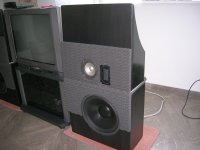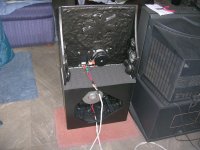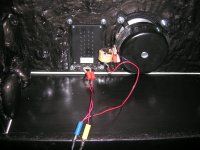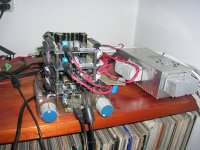Solar Panels damage : A curved panel would absorb an impact considerably. Isn't it ?
Regards.
Regards.
Value measured in dollars only is for the dreaded bean-counter. I suspect he has gone a good way towards ROI.he didn't expect ROI.
But at a considerable loss of efficiency.Solar Panels damage : A curved panel would absorb an impact considerably. Isn't it ?
Regards.
Ok, so, its cool for you. Use the very cheap TL072 everywhere, and you will have a PERFECT system... for you.
For me, > 95% of the system i listen to in audio shows or show rooms, i would not spend a single penny for them.
Btw, it is not "sound like this/sound like that". It is subtle details like basses consistency, precise localization of the kick drum, as an example, little details more or less revealed and easy to discover, like nails on the guitar chords, sticks on the cymbals and their size/metal, hammers on the piano chords, separation between instruments, fluidity or harshness of some trebles, spacial stability, space between instruments, sound stage, depth of the spacial image, absence of fatigue during long listening...
Right. How many of these subtle effects would you notice going from say a NE5532 to an OPA275 (which I believe you mentioned favorably) when you cannot look at which chip is socketed? (Let's assume that it's properly bypassed, and generally lightly loaded in a Sallen-Key in your mixer). They're very similar enough from first blush, accepting the different topology, even in their caveats.
Not that there's anything terribly wrong with the TL072, but it's probably not my first choice for most positions. There are certainly better JFET input parts today for good prices. And, as I've said earlier when John asked about quality all-around monolithic opamps, I'll probably be using the OPA165X in a few places, acknowledging it's not perfect. It's probably overkill all in all, but one I can handle at ~$0.75/channel. Then again, don't expect any subjective reviews about whatever I make either; hopefully it'll be along the lines of "nothing blew up and no surprises".
If that is real, most likely down to circuit dependancies and interactions, rather than intrinsic to the IC - not necessarily repeatable between designs then IMO. Whether possession of a 'sonic signature' at all is a good thing from a design perspective is also a matter of opinion...........I tried 3 different IC's for the input stage, and I got 3 different sonic signatures.
I had a solar system installed this year just to reduce monthly electric bills. I did not go completely off the grid. Parts and installation was free if I gave them my tax credits etal.
I dont have a battery backup system..... just lower day time usage costs when rates are highest. The inverter will last maybe 10 years and crap out. But all panels and inverter are owned and operated by solar company.... just like the regular utility company so they fix and maintain everything and I have lower operating costs and less fossil fuel burning here....... but dont know how much fossil fuel is consumed in making the panels. ?? They have a 20 year life...... but loose efficiency by 1-2% a year so they should be replaced after 10 - 15 years IMO and also get the benefit of higher efficiency panels at that time.
THx-RNMarsh
.
I dont have a battery backup system..... just lower day time usage costs when rates are highest. The inverter will last maybe 10 years and crap out. But all panels and inverter are owned and operated by solar company.... just like the regular utility company so they fix and maintain everything and I have lower operating costs and less fossil fuel burning here....... but dont know how much fossil fuel is consumed in making the panels. ?? They have a 20 year life...... but loose efficiency by 1-2% a year so they should be replaced after 10 - 15 years IMO and also get the benefit of higher efficiency panels at that time.
THx-RNMarsh
.
Last edited:
Yes. There's what the system is capable of, and being readily able to defeat it or configure it for non-critical listening............Except:
a) with Vinyl one might want a switchable early roll off for some recordings
b) When watching movies with TV hooked through stereo bass is generally over cooked for my tastes
c) late at night, sprogs asleep and I want to listen to music and not shake the house
Just because I can doesn't necessarily mean I should of course...
The true measure of design success 😉"nothing blew up and no surprises".
Yes. There's what the system is capable of, and being readily able to defeat it or configure it for non-critical listening............
Well that is the extra-special case of wife and sprogs out 🙂
Amongst lots of 'bizzare' ideas I think of, one is to get a most wide band driver; add appropriate tweeter and woofer. Have the option to band pass them. And depending on music have the option of hearing only wideband or wideband+woofer or all three of them. Wonder if such system can be designed ? I know 2.1 system. But it uses two way stereo speakers and a subwoofer.
Regards.
Along the lines of your thought, I am strangling with my system.
Problem 😀 is that with MiniDSP there is a plethora of parameters to adjust (resulting in a ‘different loudspeaker’ each time) and I can’t decide which set of them is the best to settle on.
There are some settings good for different kinds of music (and each of them constantly adjusted in quest of optimization) but not one set for all kinds of music.
George
Attachments
Last edited:
All that un-cased electronics and I don't hear Gpapag screaming "too much interference".
Attention to loop areas for both low current and high current circuits can make our systems quite interference tolerant.
Attention to loop areas for both low current and high current circuits can make our systems quite interference tolerant.
Well, it's all in the, level, ahem.
Well, his lot is good for 1/4th of the annual eu-glue.
So when it comes to ancient accelerators, I'm sure he's right.
(you actually made a point also I can agree with. 1:1)
Last edited:
All that un-cased electronics and I don't hear Gpapag screaming "too much interference".
Andrew this the benefit of I2S boards interconnection. Total silence.
Green trace is amplifier output signal tapped at loudspeaker terminals.
Class D amp output is balanced, audio card input is unbalanced, so measurement was through a 1:3 step up transformer (AUSO ELA 75-03 213).
Therefore, the measured signal is 9.8dB lower than green plots show.
(MiniDSP x-over set to flat, no filters. Loudspeaker was a MLQW Jordan JX92S. Volume setting refers to digital volume of MiniDSP 2x4)
Attention to loop areas for both low current and high current circuits can make our systems quite interference tolerant.
All psu dc feed lines are twisted, as are the speaker cables.
George
Attachments
-
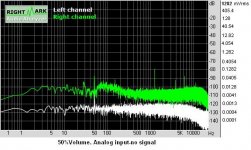 50%Volume analog input-no signal.JPG52.3 KB · Views: 231
50%Volume analog input-no signal.JPG52.3 KB · Views: 231 -
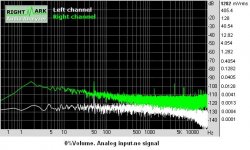 0%Volume analog input-no signal.JPG51 KB · Views: 228
0%Volume analog input-no signal.JPG51 KB · Views: 228 -
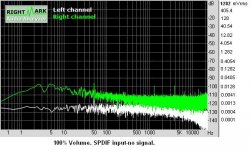 100% Volume SPDIF Input-no signal.JPG51.7 KB · Views: 242
100% Volume SPDIF Input-no signal.JPG51.7 KB · Views: 242 -
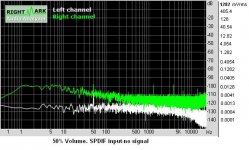 50% Volume SPDIF Input-no signal.JPG50.9 KB · Views: 236
50% Volume SPDIF Input-no signal.JPG50.9 KB · Views: 236 -
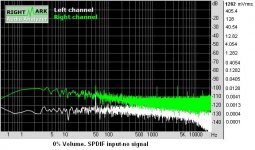 0% Volume SPDIF Input-no signal.JPG51.2 KB · Views: 246
0% Volume SPDIF Input-no signal.JPG51.2 KB · Views: 246 -
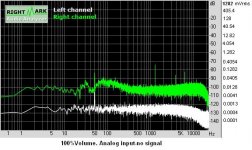 100%Volume analog input-no signal.JPG52.3 KB · Views: 80
100%Volume analog input-no signal.JPG52.3 KB · Views: 80
Last edited:
Thank you sir. Good to know the possibilities and limitations. I was thinking of no adjustments. Just imagine a three way stereo speaker where one can have options of listening to single or multiple drivers. Imagine speakers enclosure like B&W Nautilus 801. So if Music is vocal i.e. mostly midrange one can use only wideband driver. The rest are 'off'. For Rock etc. where bass and drums are prominent wideband and woofer, for dynamic wide range classical music all three would be 'ON'.Problem 😀 is that with MiniDSP there is a plethora of parameters to adjust (resulting in a ‘different loudspeaker’ each time)
regards.
Howie,
My version of conservation is simple. A 500 watt panel would provide all of my home needs.
The electrical inspector was surprised I only installed a 100 amp panel. Most of the circuits are for wall outlets. One problem was they do not make circuit breakers small enough for my loads. The first and second floor lighting circuits should be 1 amp each. The basement slightly less. I still have a few florescent lights but most are trending to LED.
The bathroom fan has a smart controller that recognizes when it can reduce the heat load at night.
The largest energy user is of course the refridgerator. That is why I built my own. Don't need much size but the rules for them exempt the small ones so the commercial versions are energy hogs and way too noisy.
Scott has trouble with how quiet my house is. That is due to above average insulation.
Now with masonry walls, southern exposure and no northern windows, spring and fall require little energy.
Utility bills run well under $1000 a year.
Now part that is the design is typical 1860s and the original heating system was two wood stoves. Along with the climate here which doesn't require much air conditioning. Heating worst case requires 35,000 BTUs. But that is from 10 below to 70 F. So there are other approaches.
P.S. Trees help considerable with reducing cooling needs and nicely track the seasons for when heating needs.
My version of conservation is simple. A 500 watt panel would provide all of my home needs.
The electrical inspector was surprised I only installed a 100 amp panel. Most of the circuits are for wall outlets. One problem was they do not make circuit breakers small enough for my loads. The first and second floor lighting circuits should be 1 amp each. The basement slightly less. I still have a few florescent lights but most are trending to LED.
The bathroom fan has a smart controller that recognizes when it can reduce the heat load at night.
The largest energy user is of course the refridgerator. That is why I built my own. Don't need much size but the rules for them exempt the small ones so the commercial versions are energy hogs and way too noisy.
Scott has trouble with how quiet my house is. That is due to above average insulation.
Now with masonry walls, southern exposure and no northern windows, spring and fall require little energy.
Utility bills run well under $1000 a year.
Now part that is the design is typical 1860s and the original heating system was two wood stoves. Along with the climate here which doesn't require much air conditioning. Heating worst case requires 35,000 BTUs. But that is from 10 below to 70 F. So there are other approaches.
P.S. Trees help considerable with reducing cooling needs and nicely track the seasons for when heating needs.
Along the lines of your thought, I am strangling with my system.
Problem 😀 is that with MiniDSP there is a plethora of parameters to adjust (resulting in a ‘different loudspeaker’ each time) and I can’t decide which set of them is the best to settle on.
There are some settings good for different kinds of music (and each of them constantly adjusted in quest of optimization) but not one set for all kinds of music.
George
Have you tried adjusting Xovers for lowest group-delay across the entire BW? Try it and listen.
THx-RNMarsh
Conservation
Not to belabor the subject on a Blowtorch thread...(that is what this is, right?) Your efforts at conservation are highly laudable, and represent the front-line work everyone should do for sure. that alone would take care of most of our needs with current generating capacity (punny, eh?).
Here on the Piedmont in NC, where we had 40+ 90°F days with Gulf humid air this year, air conditioning is hardly a luxury...well, if you want to work inside. This is an appropriate application for PV because you have greatest power at the time of day when your heat load is greatest. In many respects my PV is a peak load abatement device during the summer, providing 5KW max while my AC is using ~4KW. Of course we use the AC when it is dark as well, so...
To make this thread audio related: what is your consumption when you turn on the equipment in your listening room? Mine pulls 3.8A@120V idling (456W), more (~700w) when listening to Morgen Agren and Fredrik Thordendal playing Sol Niger Within at the appropriate level, low average but higher crest factor when listening to Anna Federova play Rachmaninoff at close to concert levels, and close to idle current when listening to Eno's Music for Airports at nap taking levels. I guess I am not conservative when it comes to music consumption, although I have not heard the latest crop of Class D amps either...
Howie
Howard Hoyt
CE - WXYC-FM 89.3
UNC Chapel Hill, NC
www.wxyc.org
Howie, My version of conservation is simple...
P.S. Trees help considerable with reducing cooling needs and nicely track the seasons for when heating needs.
Not to belabor the subject on a Blowtorch thread...(that is what this is, right?) Your efforts at conservation are highly laudable, and represent the front-line work everyone should do for sure. that alone would take care of most of our needs with current generating capacity (punny, eh?).
Here on the Piedmont in NC, where we had 40+ 90°F days with Gulf humid air this year, air conditioning is hardly a luxury...well, if you want to work inside. This is an appropriate application for PV because you have greatest power at the time of day when your heat load is greatest. In many respects my PV is a peak load abatement device during the summer, providing 5KW max while my AC is using ~4KW. Of course we use the AC when it is dark as well, so...
To make this thread audio related: what is your consumption when you turn on the equipment in your listening room? Mine pulls 3.8A@120V idling (456W), more (~700w) when listening to Morgen Agren and Fredrik Thordendal playing Sol Niger Within at the appropriate level, low average but higher crest factor when listening to Anna Federova play Rachmaninoff at close to concert levels, and close to idle current when listening to Eno's Music for Airports at nap taking levels. I guess I am not conservative when it comes to music consumption, although I have not heard the latest crop of Class D amps either...
Howie
Howard Hoyt
CE - WXYC-FM 89.3
UNC Chapel Hill, NC
www.wxyc.org
Last edited:
FYI, the Blowtorch thread is now in the Lounge so it doesn't have to be audio related. Just no politics or religion (though that's largely what this thread is but I digress...).
se
se
Scott has trouble with how quiet my house is. That is due to above average insulation.
No, just the claim that it's nothing special. Your reefer solution is not for everyone to say the least.
BTW, I have 8 or so peltier units with heatsinks scavenged from those 12V car coolers. You're welcome to them.
Howie,
Mine are 10 watt class A so my listening consumption is under 100 watts! I find with my low background noise level and horn loaded loudspeakers that is adequate.
Yes I knew you were in an area where AC is mandatory. I am still finishing up the basic house renovations. When I either replace the roof or add a veranda will be when I add solar panels. I will do 2 KW as that should be enough to power the 10,000 BTU of AC that would be more than enough to keep me chilled out. At my shop we sprinkle the roof. That is equal to about 3 tons of AC and then the active AC is about the same.
However running machine tools off of energy harvesting is out of the current version of reality.
BTY conservation has nothing to do with it. I am just thrifty.
Scott,
Just seeing if you were paying attention. 🙂
Thanks, but I bought 20 of the peltier gizmos and have a few still left.
Mine are 10 watt class A so my listening consumption is under 100 watts! I find with my low background noise level and horn loaded loudspeakers that is adequate.
Yes I knew you were in an area where AC is mandatory. I am still finishing up the basic house renovations. When I either replace the roof or add a veranda will be when I add solar panels. I will do 2 KW as that should be enough to power the 10,000 BTU of AC that would be more than enough to keep me chilled out. At my shop we sprinkle the roof. That is equal to about 3 tons of AC and then the active AC is about the same.
However running machine tools off of energy harvesting is out of the current version of reality.
BTY conservation has nothing to do with it. I am just thrifty.
Scott,
Just seeing if you were paying attention. 🙂
Thanks, but I bought 20 of the peltier gizmos and have a few still left.
- Status
- Not open for further replies.
- Home
- Member Areas
- The Lounge
- John Curl's Blowtorch preamplifier part II
